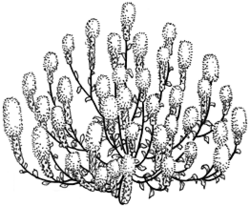Common name: Yellowtails, Regal Foxtail
Ptilotus nobilis (Lindl.) F.Muell. APNI* Synonyms: Ptilotus nobilis (Lindl.) F.Muell. subsp. nobilis APNI*
Trichinium exaltatum (Nees) Benth. APNI*
Ptilotus nobilis (Lindl.) F.Muell. subsp. nobilis APNI*
Ptilotus nobilis (Lindl.) F.Muell. var. nobilis APNI*

Description: Erect taprooted perennial to 1 m high, glabrous except for young shoots and axils.
Basal leaves lanceolate or spathulate, 5–15 cm long, 1–3.5 cm wide, glabrous. Cauline leaves spathulate to oblong-lanceolate, to 13 cm long, to 6 cm wide.
Inflorescence oblong to cylindrical, 5–20 cm long, 4–5 cm diam., purple pink or creamy-white to greenish-white. Bracts hairy, ovate to lanceolate, apex often glabrous, acuminate to mucronate; bracteoles similar to bracts. Perianth segments 20–25 mm long; outer surface hairy with woolly hairs mixed with longer straight hairs, apex glabrous and truncate; inner surface glabrous except for some long hairs at base. Stamens 3 or 4, staminodes 2 or 1. Ovary glabrous or with scattered hairs near the top, shortly stalked; style glabrous.
Distribution and occurrence: Widespread. In open shrublands, grasslands and open stony plains, typically on fine-textured, loamy or clayey soils.
NSW subdivisions: NWS, NWP, SWP, NFWP, SFWP
Other Australian states: Qld S.A. N.T.
Bean (2008) united Ptilotus nobilis and P. exaltatus, but a morphological and ecological investigation by Hammer et al. (2017) recognises both as distinct species. In P. nobilis the hairs on the interior base of the inner tepals are sparse, scattered and erect, whereas in P. exaltatus they form a densely woolly plug. It usually has green flowers (sometimes to pale pink) and slightly to distinctly falcate-curved tepals that do not gape widely at anthesis. The tepals of P. exaltatus are always pink to purple, are ±straight, and gape widely at anthesis. Pollination is likely to be by night-flying moths. The flowers are strongly sweetly scented at night, much less so during the day.
Text by S. W. L. Jacobs & L. Lapinpuro; Updated S.McCune (July 2020)
Taxon concept: Hammer, T et al. (2018) Australian Systematic Botany 31(3): 262-280.
APNI* Provides a link to the Australian Plant Name Index (hosted by the Australian National Botanic Gardens) for comprehensive bibliographic data
***The AVH map option provides a detailed interactive Australia wide distribution map drawn from collections held by all major Australian herbaria participating in the Australian Virtual Herbarium project.
|


